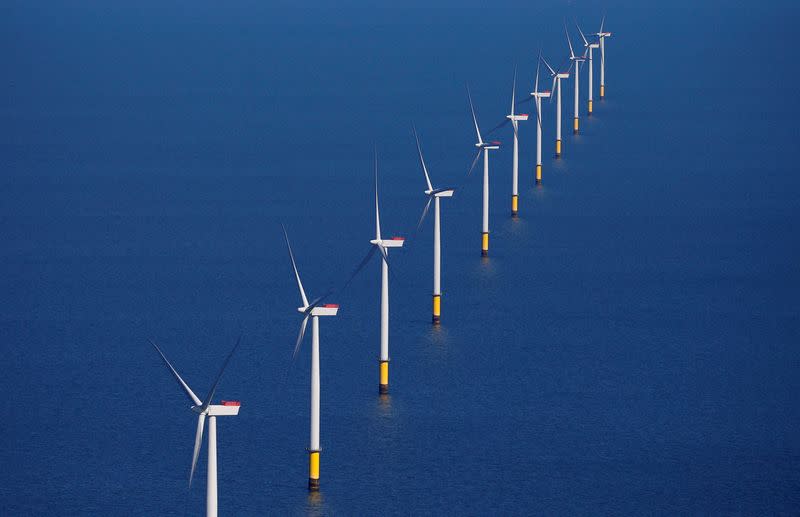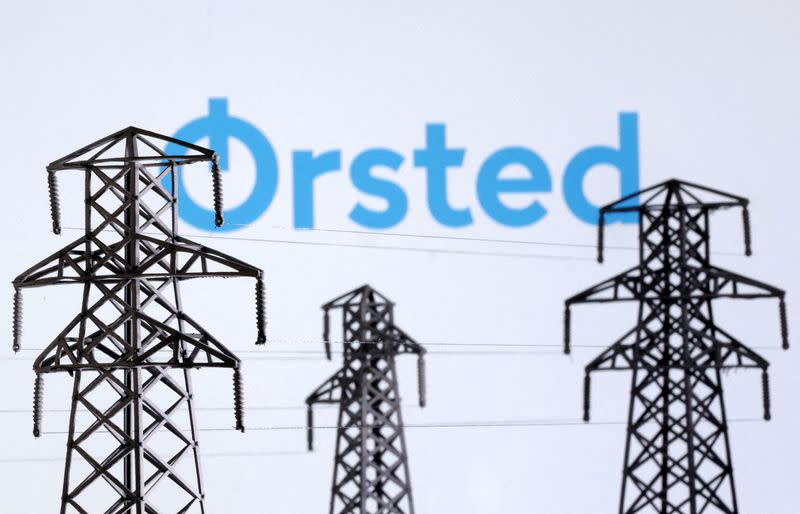Orsted to invest $68 billion in power capacity by 2030
By Terje Solsvik and Nina Chestney
OSLO/LONDON (Reuters) -Renewable energy group Orsted will invest 475 billion Danish crowns ($68 billion) to achieve a 2030 goal to install 50 gigawatts (GW) of power capacity, it said in an investor update on Thursday.
The Danish company said the plans were fully self-funded and it expected to exceed goals set in 2021 for earnings before interest, tax, depreciation and amortisation (EBITDA) as well as for return on capital employed (ROCE).
Orsted's share price closed 5.1% higher on Thursday at a two-week high, outperforming a 0.5% rise in Copenhagen's benchmark stock index.
Orsted's share price has more than halved since peaking in January 2021. Although demand for green energy is rising, the wind industry, which requires high upfront investment, has been hit by cost inflation and high interest rates.
"We're on track to outperform our previous EBITDA and ROCE targets for 2020-2027, confirming the significant value in our portfolio of renewable projects," Chief Executive Mads Nipper said in a statement.
Orsted, the world's No. 1 offshore wind farm developer by gigawatt capacity, operates 15.5 GW of renewable energy assets. Capacity of 4.9 GW is under construction and projects representing another 10.6 GW have been awarded, it said.
The company is cooperating closely with suppliers to secure competitive prices and ensure sufficient value in projects for which it had yet to take final investment decisions.
It said it could reconfigure or exit projects if their profitability does not meet its criteria for a final investment decision.
On whether the company would rule out an equity raise in the future, Nipper said: "We are confident we can deliver the investment plan with the current capital structure."
PLANNED BRITISH, POLISH PROJECTS
At its capital markets day in London, Orsted said it expects to take a final investment decision on its planned 2.8 GW Hornsea 3 offshore wind farm in Britain this year.
Orsted said in early March the project may not go ahead unless the British government provided more support such as tax breaks.
Rasmus Errboe, Orsted's CEO of Europe, also said the company anticipated its planned Baltica 2 offshore wind project in Poland would create sufficient value, but it had decided to reconfigure the Baltica 3 project - possibly by increasing the size of the turbine to add more capacity.
Orsted has a joint venture with Polish state-owned utility PGE to develop the wind farms that so far have a combined capacity of 2.5 GW and were scheduled to come online this decade.
David Hardy, CEO of Americas, said the company will focus on the mid-Atlantic and northeastern wind markets of the U.S. East Coast.
It has also decided to reconfigure its planned 1.1 GW Ocean Winds 2 offshore wind project, which could lead to a delay in the 2029 timeline or to a different technology being used.
Orsted's 1 GW Skipjack Wind project possibly also faces delay because of issues with the required transmission system, Hardy said.
Orsted has been using farmdowns, meaning a utility develops a facility that is divested in part after commissioning.
It expects to raise around 20 billion Danish crowns a year from farmdowns from 2023 to 2030 and its ownership of some of its assets could fall below 50%, Chief Financial Officer Daniel Lerup said.
($1 = 6.9523 Danish crowns)
(Reporting by Terje Solsvik and Nina Chestney; Editing by Barbara Lewis, Emelia Sithole-Matarise and Jonathan Oatis)

 Yahoo Finance
Yahoo Finance 

